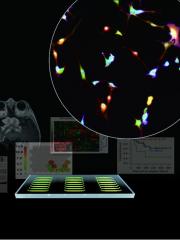Aug 4 2010
New technologies for the diagnosis of cancer are rapidly changing the clinical practice of oncology. As scientists learn more about the molecular basis of cancer, the development of new tools capable of multiple, inexpensive biomarker measurements on small samples of clinical tissue will become essential to the success of genetically informed and personalized cancer therapies.
Researchers at UCLA have now developed a microfluidic image cytometry (MIC) platform that can measure cell-signaling pathways in brain tumor samples at the single-cell level. The new technology combines the advantages of microfluidics and microscopy-based cell imaging.
 The microfluidic imaging cytometry (MIC) platform incorporates microfluidic manipulation and imaging of tumor biopsies with bioinformatic analysis. The single cell-based tumor characterization provided is being developed for a systems pathology approach to tumor diagnostics and personalized medicine.
The microfluidic imaging cytometry (MIC) platform incorporates microfluidic manipulation and imaging of tumor biopsies with bioinformatic analysis. The single cell-based tumor characterization provided is being developed for a systems pathology approach to tumor diagnostics and personalized medicine.
The ability to make these in vitro molecular measurements, or "fingerprints," marks a new advance in molecular diagnostics that could ultimately help physicians predict patient prognosis and guide personalized treatment.
"The MIC is essentially a cancer diagnostic chip that can generate single-cell 'molecular fingerprints' for a small quantity of pathology samples, including brain tumor tissues," said Dr. Hsian-Rong Tseng, a UCLA associate professor of molecular and medical pharmacology and one of the leaders of the research. "We are exploring the use of the MIC for generating informative molecular fingerprints from rare populations of oncology samples — for example, tumor stem cells."
The research, which appears in the Aug. 1 issue of the journal Cancer Research, represents the teamwork of 35 co-authors from UCLA's Jonsson Comprehensive Cancer Center with expertise in surgery, pathology, cancer biology, bioinformatics and diagnostic devices.
Led by Tseng and Thomas Graeber, an assistant professor of molecular and medical pharmacology, both of whom are researchers at the Crump Institute for Molecular Imaging at the David Geffen School of Medicine at UCLA and the California NanoSystems Institute (CNSI) at UCLA, the team analyzed a panel of 19 human brain tumor biopsies to show the clinical application of the MIC platform to solid tumors.
The researchers also developed new bioinformatics — computational and statistical techniques and algorithms — that allowed them to process and analyze the data gleaned from the MIC platform's single-cell measurements.
"Because the measurements are at the single-cell level, computational algorithms are then used to organize and find patterns in the thousands of measurements," Graeber said. "These patterns relate to the growth signaling pathways active in the tumor that should be targeted in genetically informed or personalized anticancer therapies."
"The single-cell nature of the MIC brain tumor data presented an exciting and challenging opportunity," said Dr. Nicholas Graham, a postdoctoral scholar at the CNSI who worked out the data analysis. "To make sense of the data, we had to develop some new bioinformatics approaches that would preserve the power of single-cell analysis but allow for comparison between patients."
Molecular and medical pharmacology graduate researcher Michael Masterman-Smith approached the project as a translational cancer biologist.
"When we incorporated patient outcome data into our analyses and found that these 'biosignatures' clustered to reveal distinctive signaling phenomena that correlated with outcome, it got truly exciting," he said.
Microscale technology platforms are finding wide application in biological assays in which careful manipulation and measurement of limited sample amounts are required, and the new MIC platform is capable of making molecular measurements on small tumor samples provided by tumor resection and biopsy using as few as 1,000 to 3,000 cells, according to the researchers.
"The promise and attractiveness of this approach is the small amount of tissue needed for analysis in the face of increasing numbers of prognostic and predictive markers, and the possibility of quantifying tumor genetic heterogeneity," said Dr. William Yong, a Jonsson Cancer Center physician-scientist who led the pathology aspects of the research. "However, much work remains to validate this study with larger sample sizes and with more markers."
"We are excited about the possibility of using this method to investigate responses of individual tumors to potential therapeutics, as well as to enhance our knowledge about how they become resistant to therapies," said Dr. Harley Kornblum, a physician-scientist who studies brain tumor biology and is a member of both UCLA's Intellectual and Developmental Disabilities Research Center and the Johnson Cancer Center cell biology program area.
"Scientific, medical and engineering disciplines each have their own approach to problem-solving" said Dr. Jing Sun, a postdoctoral scholar at CNSI and an organic chemist. "For the innovative process to yield something useful, it must be faster, better, cheaper and — of course, with microscale technologies — smaller."
The researchers will next apply the new platform to larger cohorts of cancer patient samples and integrate the diagnostic approach into clinical trials of molecular therapies.
Source: http://www.ucla.edu/